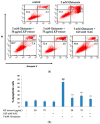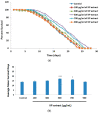Kaempferia parviflora Rhizome Extract Inhibits Glutamate-Induced Toxicity in HT-22 Mouse Hippocampal Neuronal Cells and Extends Longevity in Caenorhabditis elegans
- PMID: 33810282
- PMCID: PMC8066628
- DOI: 10.3390/biology10040264
Kaempferia parviflora Rhizome Extract Inhibits Glutamate-Induced Toxicity in HT-22 Mouse Hippocampal Neuronal Cells and Extends Longevity in Caenorhabditis elegans
Abstract
Kaempferia parviflora Wall. ex Baker (KP) or "Kra-chai-dam" has been shown to exhibit several pharmacological effects including anti-inflammation, antimicrobial, and sexual-enhancing activity. The objectives of this study included an investigation of the effect of KP rhizome extract against glutamate-induced toxicity in mouse hippocampal HT-22 neuronal cells, determination of the underlying mechanism of neuroprotection, and an evaluation of the effect of KP extract on the longevity of Caenorhabditis elegans. HT-22 cells were co-treated with glutamate (5 mM) and KP extract (25, 50, and 75 μg/mL) for 14 h. Cell viability, intracellular reactive oxygen species (ROS) assay, fluorescence-activated cell sorting (FACS) analysis, and Western blotting were performed. The longevity effect of KP extract on C. elegans was studied by lifespan measurement. In HT-22 cells, co-treatment of glutamate with KP extract significantly inhibited glutamate-mediated cytotoxicity and decreased intracellular ROS production. Additionally, the glutamate-induced apoptosis and apoptotic-inducing factor (AIF) translocation were blocked by KP extract co-treatment. Western blot analysis also demonstrated that KP extract significantly diminished extracellular signal-regulated kinase (ERK) phosphorylation induced by glutamate, and brain-derived neurotrophic factor (BDNF) was recovered to the control. Moreover, this KP extract treatment prolonged the lifespan of C. elegans. Altogether, this study suggested that KP extract possesses both neuroprotective and longevity-inducing properties, thus serving as a promising candidate for development of innovative health products.
Keywords: Caenorhabditis elegans; HT-22 mouse hippocampal neuronal cells; Kaempferia parviflora rhizome extract; glutamate toxicity.
Conflict of interest statement
The authors declare no conflict of interest.
Figures









Similar articles
-
Ethanolic extract of Streblus asper leaves protects against glutamate-induced toxicity in HT22 hippocampal neuronal cells and extends lifespan of Caenorhabditis elegans.BMC Complement Altern Med. 2017 Dec 28;17(1):551. doi: 10.1186/s12906-017-2050-3. BMC Complement Altern Med. 2017. PMID: 29282044 Free PMC article.
-
Ethanolic extract of Kaempferia parviflora interrupts the mechanisms-associated rheumatoid arthritis in SW982 culture model via p38/STAT1 and STAT3 pathways.Phytomedicine. 2019 Jun;59:152755. doi: 10.1016/j.phymed.2018.11.015. Epub 2018 Nov 14. Phytomedicine. 2019. PMID: 31005814
-
Kaempferia parviflora Extract Alleviated Rat Arthritis, Exerted Chondroprotective Properties In Vitro, and Reduced Expression of Genes Associated with Inflammatory Arthritis.Molecules. 2021 Mar 11;26(6):1527. doi: 10.3390/molecules26061527. Molecules. 2021. PMID: 33799537 Free PMC article.
-
A systematic review and meta-analysis of animal and human studies demonstrates the beneficial effects of Kaempferia parviflora on metabolic syndrome and erectile dysfunction.Nutr Res. 2024 Feb;122:80-91. doi: 10.1016/j.nutres.2023.12.001. Epub 2023 Dec 5. Nutr Res. 2024. PMID: 38194854
-
Kaempferia parviflora and Its Methoxyflavones: Chemistry and Biological Activities.Evid Based Complement Alternat Med. 2018 Dec 16;2018:4057456. doi: 10.1155/2018/4057456. eCollection 2018. Evid Based Complement Alternat Med. 2018. PMID: 30643531 Free PMC article. Review.
Cited by
-
Screening of the active Ingredients in Huanglian Jiedu decoction through amide bond-Immobilized magnetic nanoparticle-assisted cell membrane chromatography.Front Pharmacol. 2022 Dec 19;13:1087404. doi: 10.3389/fphar.2022.1087404. eCollection 2022. Front Pharmacol. 2022. PMID: 36642988 Free PMC article.
-
HIV-1 Protease and Reverse Transcriptase Inhibitory Activities of Curcuma aeruginosa Roxb. Rhizome Extracts and the Phytochemical Profile Analysis: In Vitro and In Silico Screening.Pharmaceuticals (Basel). 2021 Oct 31;14(11):1115. doi: 10.3390/ph14111115. Pharmaceuticals (Basel). 2021. PMID: 34832897 Free PMC article.
-
Skin Rejuvenation Efficacy and Safety Evaluation of Kaempferia parviflora Standardized Extract (BG100) in Human 3D Skin Models and Clinical Trial.Biomolecules. 2024 Jun 29;14(7):776. doi: 10.3390/biom14070776. Biomolecules. 2024. PMID: 39062490 Free PMC article. Clinical Trial.
-
Elucidating the Neuroprotective Mechanism of 5,7-Dimethoxyflavone and 5,7',4'-Trimethoxyflavone Through In Silico Target Prediction and in Memory-Impaired Mice.Neurochem Res. 2025 Aug 21;50(5):274. doi: 10.1007/s11064-025-04524-6. Neurochem Res. 2025. PMID: 40839147 Free PMC article.
-
Kaempferia parviflora Extracts Protect Neural Stem Cells from Amyloid Peptide-Mediated Inflammation in Co-Culture Model with Microglia.Nutrients. 2023 Feb 22;15(5):1098. doi: 10.3390/nu15051098. Nutrients. 2023. PMID: 36904098 Free PMC article.
References
-
- World Health Organization Thailand: Alzheimers/Dementia 2017. [(accessed on 10 July 2020)];2017 Available online: https://www.worldlifeexpectancy.com/thailand-alzheimers-dementia.
-
- Joseph T.C., Pamela P. Oxidative Stress, Glutamate, and Neurodegenerative Disorders. Science. 1993;262:689–695. - PubMed
Grants and funding
LinkOut - more resources
Full Text Sources
Other Literature Sources
Medical
Miscellaneous

